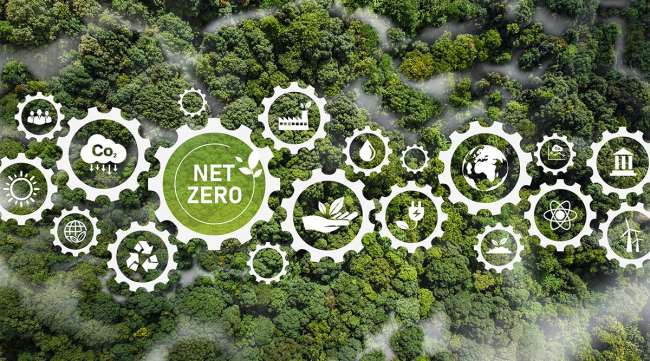What’s Next for Alternative Fuels?

[Find the latest in equipment & maintenance: Explore this quarter's issue of Calibrate]
Transport Topics’ Magazine Event Series sought to learn how today’s fleets are working to meet the heights of operational efficiency and new sustainability goals. In that quest, the question soon became, “What would this mean for the future of the internal combustion engine?” During our latest series, SPARK, we asked what will be the next step in the investments of alternative fuels and electric vehicles for fleets? Who is engineering the latest advances in equipment and which will be the right choice for your fleet? Here are a few highlights of what the industry experts thought.
Passion for Sustainability
During his keynote discussion, Srikanth Padmanabhan, president of Cummins’ Engine Business, expressed his deep commitment to environmental stewardship and the goal of leaving the world in a better state for future generations. He said the goal of sustainability is a driving force behind the engine maker’s efforts to reduce carbon emissions. Through its Destination Zero initiative, Cummins established an emissions reduction goal to achieve zero emissions by 2050, with a 30% reduction in carbon intensity by 2030 based on 2019 standards.
“I want to be able to tell my grandkids that I actually did something about climate change. I actually helped with decarbonization and we are leaving this place better than we found it,” he said.
The More Things Change…
Navistar has also set an ambitious goal to have 50% of its new vehicles be zero-emission by 2030, provided charging capacity is available. Navistar’s commitment to sustainable mobility also means that 50% of its portfolio in 2030 will still consist of internal combustion engines.“ So, for us, to have a highly efficient, reliable and sustainable combustion engine is a key,” said Michael Grahe, executive vice president of operations at Navistar. “This is why we are working on the S13 Integrated powertrain to bring this for the 50% remaining volume and have a great solution.”

Grahe
He also drew historical parallels between the challenges of today to the transition from horses to fuel trucks at the turn of the last century. He said that critics had similar anxieties about the arrival of the internal combustion engine, but ultimately, the industry adapted and thrived. This experience provides confidence that the transition to cleaner technologies will also succeed. “This is the strength, I think, especially here in the North America, that now we are in an implementation mode so that the question of ‘if’ is gone, it’s just ‘how,’ ” Grahe said. “And everybody’s working together now to implement this and to move forward.”
Realizing Opportunities
During the event series, we asked Julie Blumreiter, co-founder of ClearFlame Engine Technologies, about how nitrogen oxides regulations played a significant role in realizing the potential value of the company. The company observed how these regulations affected the competitive advantages of different truck manufacturers.
By using cleaner-burning fuels upfront, it aimed to meet these regulations without adding complexity. In the long term, its development path includes simplifying aftertreatment systems, diverging from the increasing complexity and expense of diesel aftertreatment. Its goal is to provide a simpler and more cost-effective solution that still meets strict state goals, such as those in California.
Having the Same Emissions Goals
BJ Johnson, co-founder of ClearFlame, talked about the impact of state and federal regulations on the introduction of technologies like ClearFlame’s and the adoption of alternative fuels in the trucking industry.
SPARK: The Future of the Internal Combustion Engine
Transport Topics’ Magazine Event Series, SPARK, is a half-day virtual event with learning sessions dedicated to providing specific insights for fleet maintenance and operations decision-makers. To learn more and view the replay, visit https://www.ttnews.com/ttmes/spark.
Advocating for technology-agnostic regulations, Johnson said ClearFlame wants to emphasize the importance of not forcing specific technologies, and instead focusing on the goal of reducing emissions. He also argued that ClearFlame, as a fuel choice, can not only be cost-competitive but can contribute to carbon negativity, aligning with the goal of achieving zero emissions and addressing climate change.
“So, if your goal is zero emissions, how can you not say that doesn’t apply to negative emission technologies?” he said. “And that’s where we fit in. I think ultimately the world will reconvert back to that reality because it is what matters, if the goal is to solve climate change as it would be. We support these regulations. We just want to see them done in an intelligent way.”
The Importance of Decarbonizing Transportation

More Q4 Calibrate
►Military Vets Fill Technician Roles
►Freeze: Spotlight on Technicians
►Buses Leading Race to Electrification
►What's Next for Alternative Fuels?
►Baxter: Confronting Climate Change
►TMC Corner: Cybersecurity Issues
Explore the Issue!
Ryan Manthiri, project leader at Shell Global Solutions, highlighted that the transportation sector accounts for about 35% of global energy usage, with road freight transport being a major contributor. Manthiri led Shell’s Starship Initiative that started in 2018, which has now advanced to Starship 3.0. Manthiri said the project was intended to be a material demonstration of how the industry can work together to drive significant reductions in energy usage and CO2 emissions. Collaboration with partners like Cummins, with the use of its existing natural gas engine, along with other efficiency-promoting technologies, such as Shell’s renewable natural gas and low-friction lubricants, were crucial in achieving sustainability goals.
Manthiri noted that the future of alternative fuels like natural gas will consist of “a mosaic of solutions” that help the sector achieve its emission and emission abatement targets. “So you’ll see natural gas and hydrogen take a more prominent role in that transition. I don’t think it’ll be a situation of one replaces the other,” he said. “I think natural gas will still continue to play a significant role in helping the sector get to where it needs to be.”
Want more news? Listen to today's daily briefing below or go here for more info:




